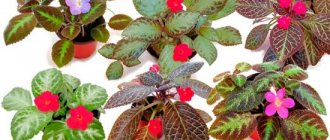Marigolds are one of the most popular flowers that every person has encountered. Its attractiveness and popularity is due to its lush and long flowering, and the flower heads have various rich shades from lemon yellow to red and fiery brown, attracting the eye from afar. In our article about marigolds, we will tell you about existing varieties, the features of growing these plants, and also answer questions about what else marigolds are useful for and how they can be used.
Rules for planting in the ground and recommendations
From planting seeds to transplanting plants into the ground, it takes about 6-8 weeks (about 2 months). Marigolds prefer soils with neutral or slightly acidic pH = 6.0-7.0. It is best to pre-enrich the soil with compost; this will also be a good solution for the drainage function. Several recommendations for transplanting seedlings into the ground:
- Transplantation dates: end of May/beginning of June;
- Feed young plants before flowering 2-3 times with complex fertilizer;
- When planting, the stem of each plant goes 2 cm deep into the soil;
- The distance between marigolds in flower beds when planting depends on their height and variety. Low-growing ones are planted at a distance of about 20 cm from each other, tall ones need more space, so a distance of 30-40 cm is maintained between plants.
Main types and varieties with photos and names
Gardeners grow many different types of marigolds, but the most popular varieties consist of just 3 types, namely: deflected (short-growing), erect (often tall), and fine-leaved (rare in mid-latitudes). The varieties are distinguished by their diversity. The flowers can be large or small, densely or broadly bronzed, and in various shades of orange, brown and yellow.
Erect marigolds (Tagetes erecta), or African
In this genus there are giants so tall that their height can reach from 0.3 to 1 meter. Most often there are double inflorescences, painted in one shade and no more than 15 centimeters in diameter.
Popular varieties:
- Vanilla - bush height up to 0.7 m, diameter of white-cream inflorescences reaches 12 cm.
- Kilimanjaro: 0.6-0.7 m tall, densely overgrown, spherical inflorescences.
- Antigua is a low-growing variety, up to 25 centimeters high. The stems are vertical, with large, about 15 centimeters in diameter, yellow, dark yellow, golden or orange flowers.
Low-growing, or rejected, or French marigolds (Tagetes patula)
The height of the shrubs usually does not exceed 0.6 m. Compact shrubs have a large number of both non-flowering and bursting inflorescences, usually less than 8 centimeters in diameter. It is also known as a spreading variety. The most popular varieties are from the Bonanza series, the height of which does not exceed 30 centimeters, for example, Bonanza Bolero, Bonanza Orange, Bonanza Flame, etc. Their bushes with small berry-like inflorescences with a diameter of about 5-6 centimeters have a variegated appearance. Carmen marigolds are also very decorative. Their inflorescence, which is lush, consists of wavy petals. The petals are yellow-orange in the center and brown-red at the edges.
Marigolds thin-leaved, or Mexican
Externally, they are very different from other species. They have fragrant, lacy, lacy leaves that seem to float in the air. They also have a huge number of tiny inflorescences that create a flickering fireworks effect. They can be colored in shades of yellow-gold, orange-red and orange-gold. They have been grown since 1795. Currently, there are about 70 varieties of this species. The height of the bushes does not exceed 40 centimeters. They have a very strong root system and adventitious roots under the shoots. The most popular varieties are Ursula (orange-golden), Golden Gem, Gnome, Lulu (yellow-golden) and Paprika (orange-red).
Caring for marigolds
Marigolds are unpretentious garden pets, so to enjoy their flowering, you need to follow a few rules for caring for these beautiful plants:
- The place for planting should be well lit or slightly shaded;
- The optimal temperature for full development is considered to be from 20 to 24 degrees Celsius;
- Marigolds do not like drafts, so you need to provide a protected place, at least with other plants growing nearby in the group;
- Plants tolerate drought well, but with poor watering, flowering will slow down and there will be fewer buds;
- Regular feeding has a good effect on the flowering and appearance of marigolds. They need to be applied in stages: when the plants reach a height of 10-13 cm, then when the first buds form and at the beginning of flowering;
- It is better to reapply fertilizer no earlier than after 30 days;
- The soil around the marigolds needs to be loosened and weeded;
- To prolong flowering, faded shoots can and should be removed.
How to get strong seedlings?
sowing seeds in pre-prepared grooves
The process is not particularly labor-intensive and will not tire you. If space allows, plant the seeds in individual cups. This will save you from subsequent picking of the grown shoots. In other cases, marigolds are sown in bowls or boxes and subsequently the sprouted seedlings are moved into separate pots.
Planting soil
Marigolds can also be grown on the balcony
“The soil must be disinfected”
In order for the seeds to feel comfortable, a soil mixture is prepared for them, which should contain the following mixed in equal parts:
- Forest land.
- Peat.
- Humus.
- Sand.
The proportions of the components can be slightly changed, the main thing is that the result is a light, moisture-intensive and nutritious substrate. There is no desire or time to bother with preparing the soil mixture - go to the store. There are always ready-made offers there.
marigolds should be planted at a distance of 5 - 7cm
The soil must be disinfected before use, and it does not matter whether you bought it in a package or prepared it yourself. The easiest way to do this is to leave the soil to freeze on the balcony for a couple of weeks. You can treat the soil by watering it with a fungicidal solution or a strong solution of potassium permanganate.
Sowing stage
Option for sowing marigolds followed by picking
Planting change in plastic containers is quite convenient. Drainage holes are made in the bottom of the container and then filled with moistened soil to about 1 cm. The surface of the soil mixture is leveled and seeds are scattered over it. Don't forget about the drainage layer. In this case, ordinary sand can act as it.
for planting marigolds, you should choose open areas or areas with light partial shade
Flowers such as marigolds have excellent germination rates, so don’t try to sow the soil thicker. The seeds are hidden under another centimeter (no more!) layer of soil, after which the surface of the latter is moistened with a spraying method. The container is covered with a lid, a piece of glass or film and sent to a warm place.
The sprouts will hatch in 2-4 days. In the case of old seeds or poorly germinating varieties, the process can take up to 8 days.
The emergence of seedlings is a signal to remove the film and move the containers to a cooler place. This will slow down the growth of seedlings and prevent them from stretching into thin blades of grass.
orange marigolds with a yellow border are especially attractive
Marigold sprouts show miracles of resilience, so you don’t have to worry about organizing a stable microclimate for them in terms of humidity. They will not fall and dry out if they are not watered on time. The sprouts will need the first fertilizers 14 days after replanting, picking or planting, that is, by the time the nutritional resources of the soil mixture are exhausted.
Marigold picking time
germination of marigolds in a box
You can pick marigolds from the moment the first pair of real carved leaves, characteristic of this variety, appear on them. When picking, the stems are buried in the ground up to the cotyledons. In this way, they reduce the height of the fragile stem and help to form a powerful and strong root system (additional root shoots will also appear on the buried part of the stem).
The picking process stimulates the active growth of the flower, which is a consequence of the increase in “personal” land space. The seedlings will be ready for planting in balcony containers or flower beds in 21 days.
diving marigolds
Option for planting seeds without picking
Picking is not required if the seeds are planted with a step distance of 6 cm.
A guarantee of avoiding picking marigolds will be to plant them in personal palettes. Before planting, you can soak the seeds and wait for them to “awaken”. As soon as the sprouts hatch, the seed is immediately transferred to the soil. An “incubator” for seeds is prepared from a damp cloth, which is placed on a saucer. Seeds are scattered over it and covered with film. The planting process begins on the second day. Cups are prepared for the planting period in the same way as large containers.
in order not to pick marigolds, they are planted in separate palettes
Nuances of caring for seedlings
Among the unpretentious marigolds, one species can still be distinguished, which will require some attention to its content.
We are talking about a thin-leaved variety. And, nevertheless, marigolds of all varieties will equally enjoy the correctly selected temperature regime and adequate watering. Lighting
The seedlings are transferred to a well-lit windowsill with the appearance of the first sprouts.
Temperature
bright marigolds will be a worthy decoration for any flower bed
Seeds need to be germinated at 25C. The emergence of seedlings requires changing the conditions under which the plants are located, sharply reducing the temperature by 5-7C.
Watering seedlings
The sown soil is moistened regularly. This is done by spraying its surface, rather than pouring it from a watering can. On the contrary, sprouted seedlings should be watered at the root, but try not to over-moisten the soil. The watering interval will be determined by the drying speed of its surface.
Practical benefits of marigolds
The main and main use of marigolds is decorative floriculture and landscape design. But this is not their only modern purpose! Here's where else marigolds are used:
- In cooking (as a seasoning, marigolds are used in the Caucasus to prepare an analogue of the spice saffron, which by analogy was called “Imereti saffron”);
- In the treatment of diseases (medicinal tea is brewed; Mexico is especially famous for this use of marigolds, where the leaves are used as a remedy for fever, cachexia, constipation, as a diuretic and diaphoretic; in large doses it is known to be used as an emetic);
- In pharmaceuticals (the root system of marigolds contains the antibiotic thiophene);
- In wedding and holiday ceremonies (in Thailand and India, marigolds are used to make flower garlands, decorations for holidays and weddings);
- As a national symbol (often mentioned in Ukraine, this flower is the hero of songs, poems and fairy tales).
Attention! There are several contraindications for consuming marigolds as food and medicine.
This:
- The occurrence of individual allergic reactions (swelling, redness, rash, etc.);
- Personal intolerance to the constituent parts of the plant;
- Pregnancy.
Peculiarities
Depending on the variety and type, marigolds have branched or erect stems 20-130 cm high with pinnately dissected, alternate, supra-shaped or pinnately divided green leaves of various shades. The fibrous root system can be moderately or highly developed. Peduncles are individual or collected in inflorescences and have different colors - from light yellow to deep brown and reddish-orange. The abundant flowering of marigolds begins from May-June until late autumn. They reproduce by seeds (linear achene), which in one place can independently disperse and germinate for up to 4-5 years. Not only the flowers, but also the green part of the plant have a spicy aroma.
Interesting facts about marigolds
Marigolds are plants with a rich history. They have been known for a long time and are quite well studied. These are among the most popular and used flowers among gardeners from many countries. Did you know that:
- In different countries, marigolds are called by several names. In Belarus these are “Aksamites”, in Ukraine - “Chernobrivets”, in Russia - marigolds or marigolds, in Great Britain - “marigolds” (Mary’s gold), and in Germany they are known as “Turkish carnations” or “student flowers”;
- The birthplace of flowers is America. In this area, from New Mexico and Arizona to Argentina, they grow wild;
- In the language of flowers, marigolds symbolize courage, strength and courage;
- The smell of marigold leaves is much stronger and more pronounced than the aroma emanating from the buds;
- Dried marigold flowers are the raw material for making a seasoning known in Russia and the Caucasus - it is called “Imereti saffron” (after the name of the Imereti Lowland). The spice is used to give dishes a golden and reddish hue, as well as a pleasant aroma;
- In Mexico, marigold foliage is used by local residents to treat fever and constipation;
- If you plant marigolds near cucumbers, you can thus increase the yield of the edible crop, since the aromatic plants attract natural pollinators - bees.
Imereti saffron
Video about growing and caring for marigolds
How to grow marigolds correctly. Basic care rules for beautiful and lush flowering. Join the viewing!
Marigolds are quite unpretentious and fast-growing flowers. Simple care for them will only bring pleasure, and you can enjoy flowering almost immediately after planting the seedlings in the ground and until the cold weather. A combination of different varieties of marigolds in flower beds will be an excellent solution for a beautiful garden, and the rich beneficial properties will help maintain health and keep the harvest from pests in the garden. We wish you good luck growing these flowers!











